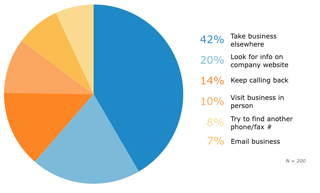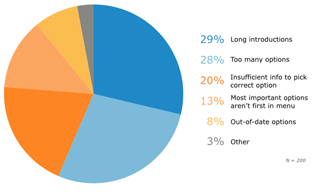 Although the world seems to believe that this whole internet fad might just be here to stay, the truth is that there is still an extremely high likelihood that you will have business coming to you from more traditional channels. No, letter-writing is a little more antiquated than I was shooting for here, but specifically the telephone is where nearly half of all consumers still prefer to conduct their business. With that high volume of potential business filtering through your phone lines, it is especially critical that it flow freely onto the desks of your employees. Yet, the real challenge here is that an alarmingly high number of consumers still feel frustrated with poorly designed telephone auto-attendants.
Although the world seems to believe that this whole internet fad might just be here to stay, the truth is that there is still an extremely high likelihood that you will have business coming to you from more traditional channels. No, letter-writing is a little more antiquated than I was shooting for here, but specifically the telephone is where nearly half of all consumers still prefer to conduct their business. With that high volume of potential business filtering through your phone lines, it is especially critical that it flow freely onto the desks of your employees. Yet, the real challenge here is that an alarmingly high number of consumers still feel frustrated with poorly designed telephone auto-attendants.
Give the People What They Want
This isn’t one of those Henry Fordisms about giving people a faster horse because they didn’t think of building a car, this is a far less abstract concept- people get impatient with terrible design. Not your company’s logo or your color scheme, but the design of the telephone architecture could be helping or hurting your business substantially. Simply stated- if someone wants to do business with you, make it as easy as possible.
According to the reliably thorough think-tank Software Advice, the expert software reviewers that revealed added benefits of both OTT Apps and SIP Trunking, we’ve been able to quantify and verify things we have suspected for a long time to be true. Specifically that if a caller doesn’t feel like staying on the line, they won’t.
 Brevity is the Lifeblood of Engaging Callers
Brevity is the Lifeblood of Engaging Callers
At the risk of violating this very simple rule, allow me to explain. Of the consumers surveyed in this most recent study from Software Advice, 42% of them said they would take their business to a competitor after a frustrating experience with a company’s auto-attendant. Nearly half of all callers to your business are ready to jump ship to your competition if your auto-attendant isn’t efficient. Even when you’re discussing succinct communication, that number is representative of enough business to warrant repeating.
These consumers have already dialed your business, which indicates they clearly want to investigate working with you. In order to keep them on the line, according to the study, the best way is to focus on two key areas, namely length of introduction messaging and complexity of menu options.

- Intro Message Length – Remember the Rule of Eight? This was the concept that messaging should be distilled to 8-second sound bites. Turns out, that’s too long. In fact, 69% businesses already have greetings less than 5-seconds long, yet consumers still prefer a 3-second greeting or less.
- Menu Options – In addition to the length of time it takes typical auto-attendant programs to send callers to the menu, the actual amount of menu options themselves were cited as the second most aggravating characteristic of poorly designed auto-attendants. Keeping the number of menu items as close to five as possible is ideal, but never any more than eight, according to respondents.
Don’t Abandon the Auto-Attendant
Very few businesses will benefit from not having an auto-attendant. Simply having an around-the-clock resource for customers can yield huge dividends, but then there is the added advantage of not requiring a receptionist, too. However, it’s obvious that the wrong auto-attendant or one that is poorly designed can also be a crippling blow to a business that can’t afford to lose 42% of their potential inbound leads.
Partnering with a modern business telephone provider will be the easiest and quickest way to test, iterate, and improve your inbound caller experience. VirtualPBX’s sleek and simple Extension Manager is fully web-based so you can take it wherever you have an internet connection, and our Customer Support Team is located right here in San Jose and ready to help you get the most out of your phone system.






